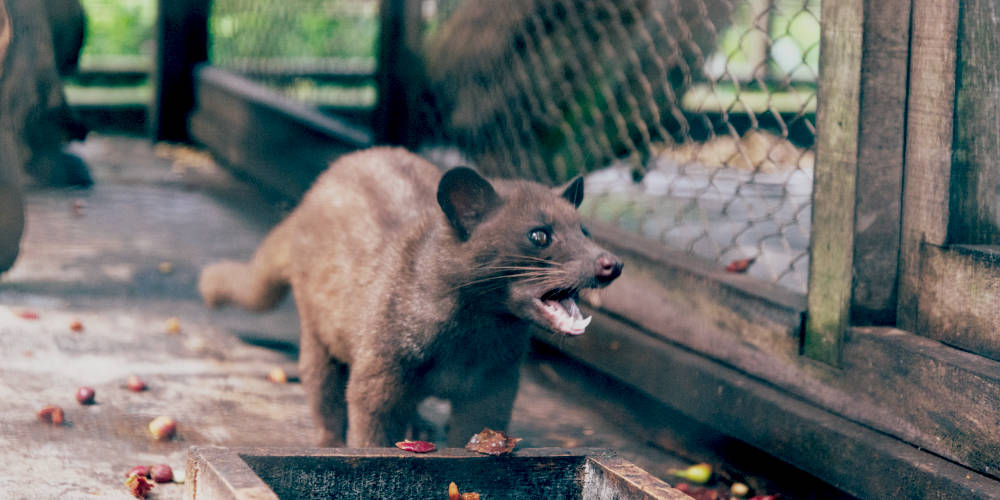Typically, the term “elite” or “luxury” coffee evolved as a result of a smart marketing strategy. In reality, this coffee does not stand out at all, except for the specific production process or the smooth, fabricated story. In this article, we’ll cover 5 most famous types of “luxury” coffee.
What is “Elite” Coffee?
According to the Thesaurus, "elite" means “rare”, “top notch” and “exclusive”; although “The Coffee Dictionary'' by Maxwell Colonna Dashwood does not mention the concept of “elite” coffee at all. Once you google search these words - the first 5 positions are quite predictable ( due to a brilliant job of marketing professionals).Below, let's take a look at each of them.
Kopi Luwak (Indonesia)

Kopi Luwak is considered one of the most expensive coffees in the world. You’ll be surprised by its origin, as it is processed in an atypical way - in the digestive tract of the animal “Luwak” (Malay palm civet or Musang), as coffee cherries are part of its diet.
Musangs, in their natural habitat ,eat the most ripe and juicy coffee cherries. The undigested beans come out later along with the excrements. The former is then collected, washed, dried, roasted and turned into an exotic coffee with an unusual history - which is very appealing to the market and consumers.
This type of coffee was mentioned for the first time in the 50s of the last century, when coffee plantations quickly spread throughout Indonesia and originated in Musangs’ historical habitats. Later, Indonesia and other Asian countries ( Vietnam being one of them) where these animals exist, featured this coffee as a tourist attraction. The wide popularity among the coffee enthusiasts was gained in the 80s of that time.
The story proved to be more than successful commercially, however it also backfired: animals were caught and put in cages, as well as fed with all possible coffee cherries. Nonetheless, Kopi Luwak has never received high appraisals in blind cuppings.
Coffee’s flavor is always determined by a whole range of factors - terroir, variety and processing method. Kopi luwak, technically speaking, is just the fermentation of coffee in an anaerobic environment, which occurs without animal's involvement. Therefore, such an exotic process does not guarantee a unique taste. Moreover, high prices provoke fakes.
“With the money you spend on this Luxury coffee, you can buy astonishing coffee from the world's best producers. Plus the production of Luwak coffee is unnatural and not aesthetically pleasing” - believes James Hoffmann, author of the “World Atlas of Coffee.”
Jacu Bird (Brazil)

Jacu is a South American type of coffee fermented inside the digestive system of the “Jacu” bird.
Several farms in Brazil’s regions where this type of “chicken” resides, decided to open a business, based on this tempting story.
Birds eat ripe coffee cherries from trees, then the pulp is digested and the beans are excreted naturally.
Farm workers collect feces, wash out the beans, dry and sell them. Similar to Kopi Luwak, the outstanding flavor cannot be obtained through bird digestion - an acceptable flavor requires a more complex set of conditions.
Black Ivory (Thailand)

Following Kopi Luwak and Jacu’s success, one can hardly be surprised, however - one of the reserves in Thailand came up with an even more unusual story. Coffee cherries are fed to elephants via an already established scheme, except the beans are not digested and come out with feces. Consequently, employees wash the beans, dry and then sell them.
Bat Geisha (Costa Rica)

A similar story involves another animal, but this time excluding the fermentation of coffee cherries in the digestive tract: the bat bites into the coffee cherry and eats all the pulp, while the bean remains on the branch until dried. In fact, the bat starts the fermentation process, and thereby, a blended coffee ( something that tastes like natural and/or honey) is created. Therefore, in this case, the matter is not related to the eating behavior of the bat, but rather to the start of the fermentation process at a time when the coffee cherry is bitten.
Blue Mountain (Jamaica)

One of the regions where cultivated the Typica variety is Blue Mountain region in Jamaica. This type of coffee was considered an expensive gourmet coffee, and the “Blue Mountain” was elevated to legendary status.
Its new reputation as an overpriced product has been launched not so long ago - an excellent example of the fact that a well-thought advertising campaign is more important than the quality of a product.
This type of coffee had its peak of popularity when well-crafted coffee was hard to come by. These days it cannot compete in quality with the best specialty coffees.
Japan buys almost the entire harvest, so it is extremely difficult to find it somewhere else. Additionally, there are many fakes at the market.
Only the product certified by the Jamaican Chamber of Coffee Industry may use the “Jamaica, Blue Mountain” registered trademark.
The island has set up a list of authorized growers and exporters which sell the authentic “Blue Mountain” coffee, in order to prevent fakes. The chamber also stamps every barrel of coffee with a “Specialty. Jamaica, Blue Mountain” lable.
In all fairness, it should be noted that coffee of this type actually has a better taste potential than other types of coffee from this list. However, in cuppings, its mark usually does not exceed 85-86 points, while its cost is in truth very high. One can buy a more exceptional coffee for the same money.
Conclusion
All "elite" types of coffee are united by their own "special" story, thanks to creative marketing professionals. As a result, the price is too high and not justified by the quality of the product. Luxury Coffee in relation to the above coffee types does not imply quality, rather exhibits the idea of a rare product that’s not affordable to many.

